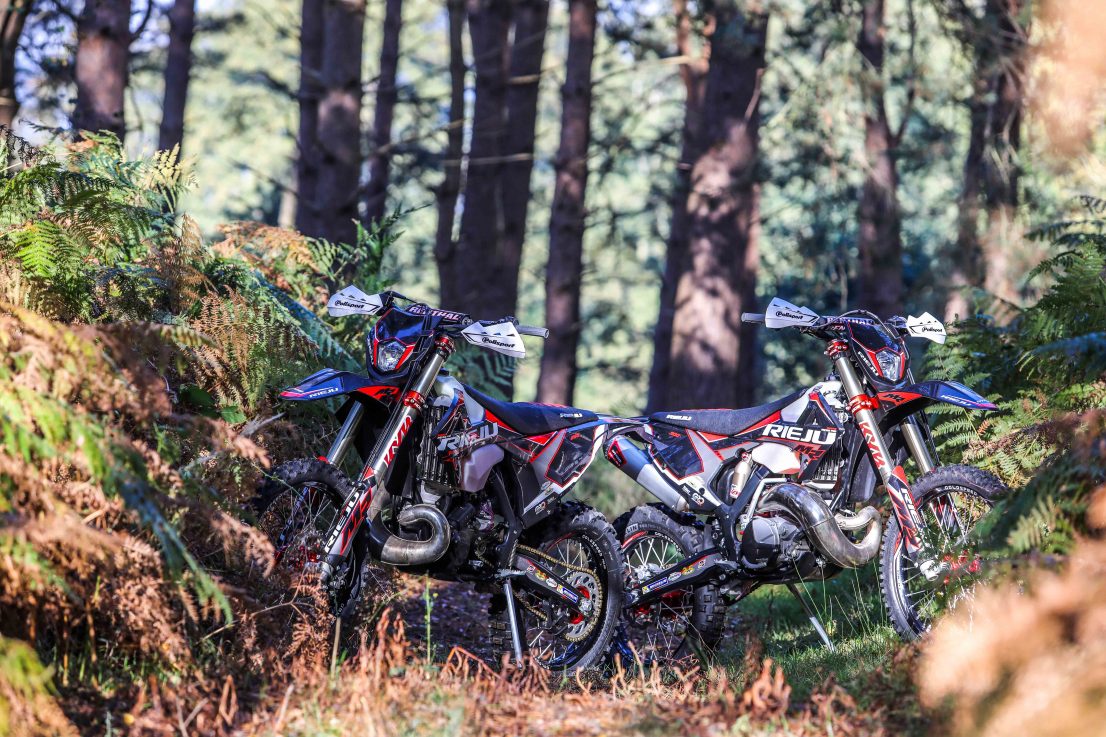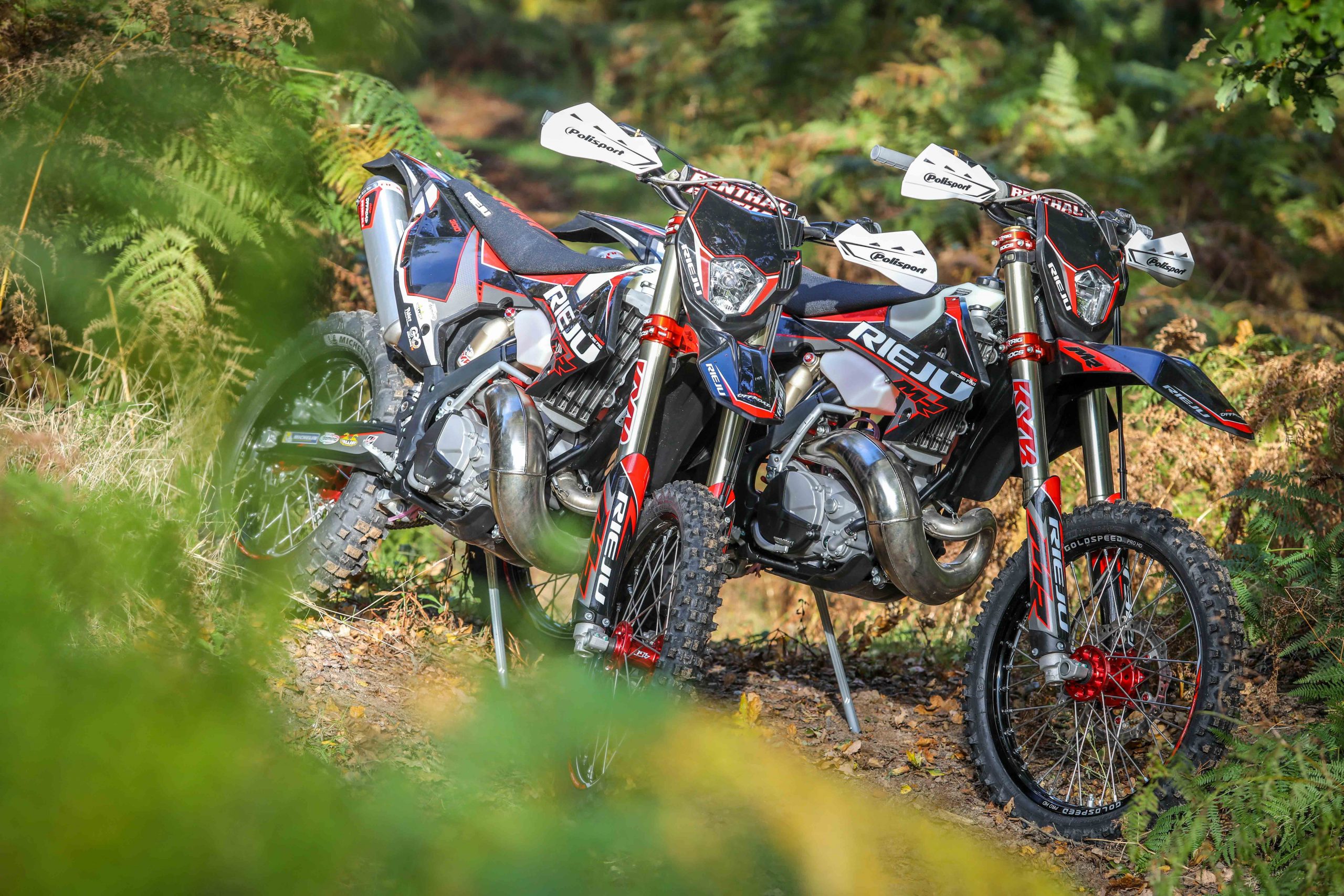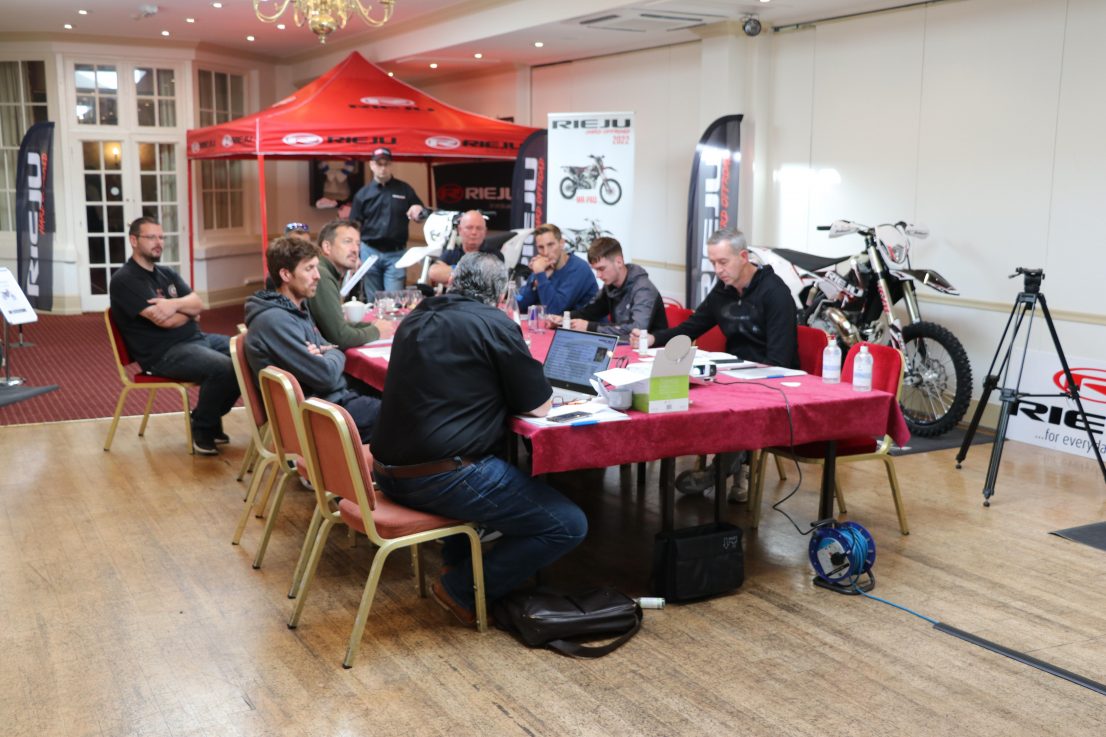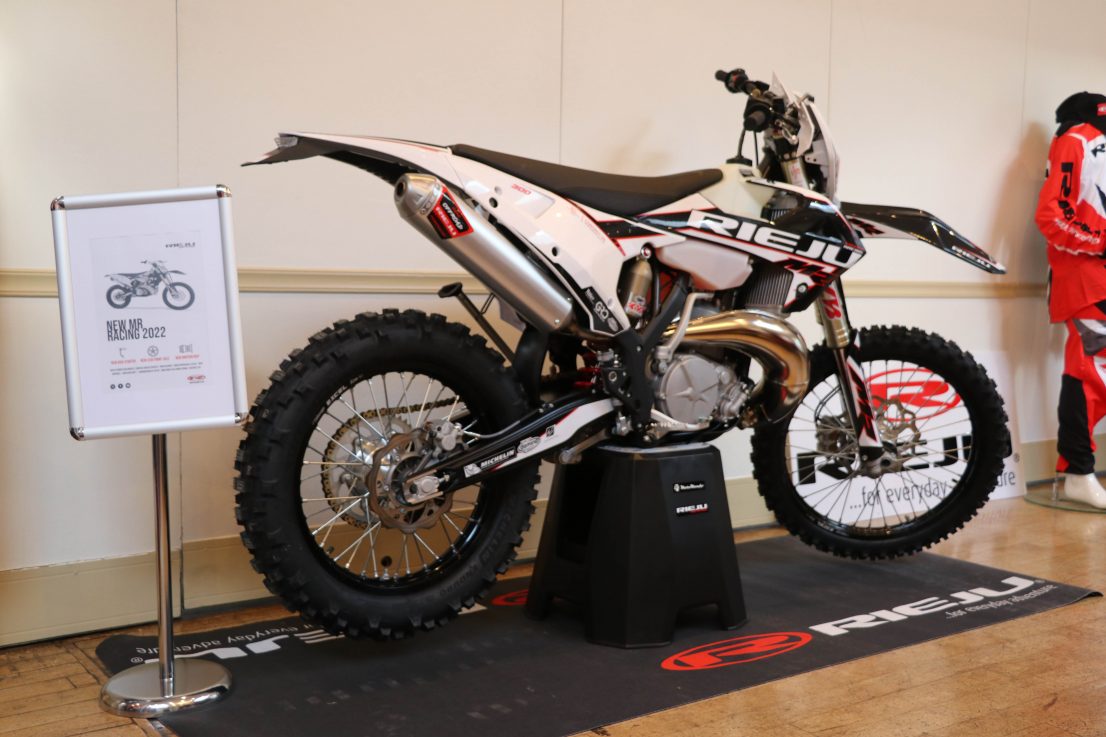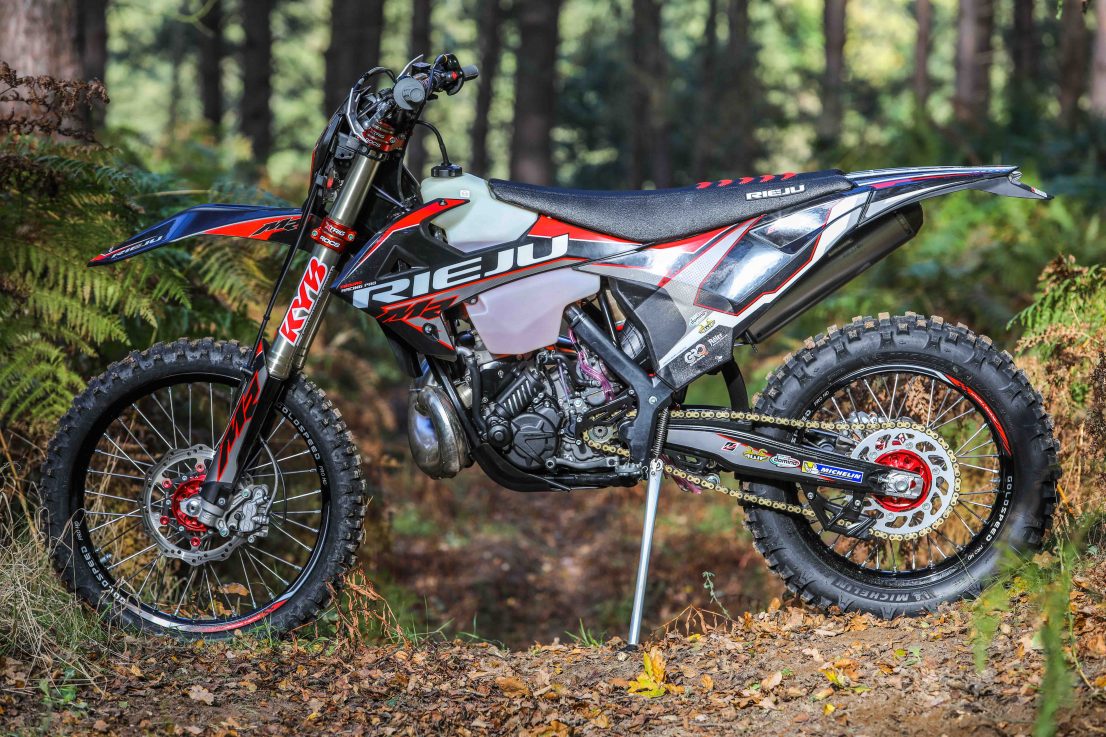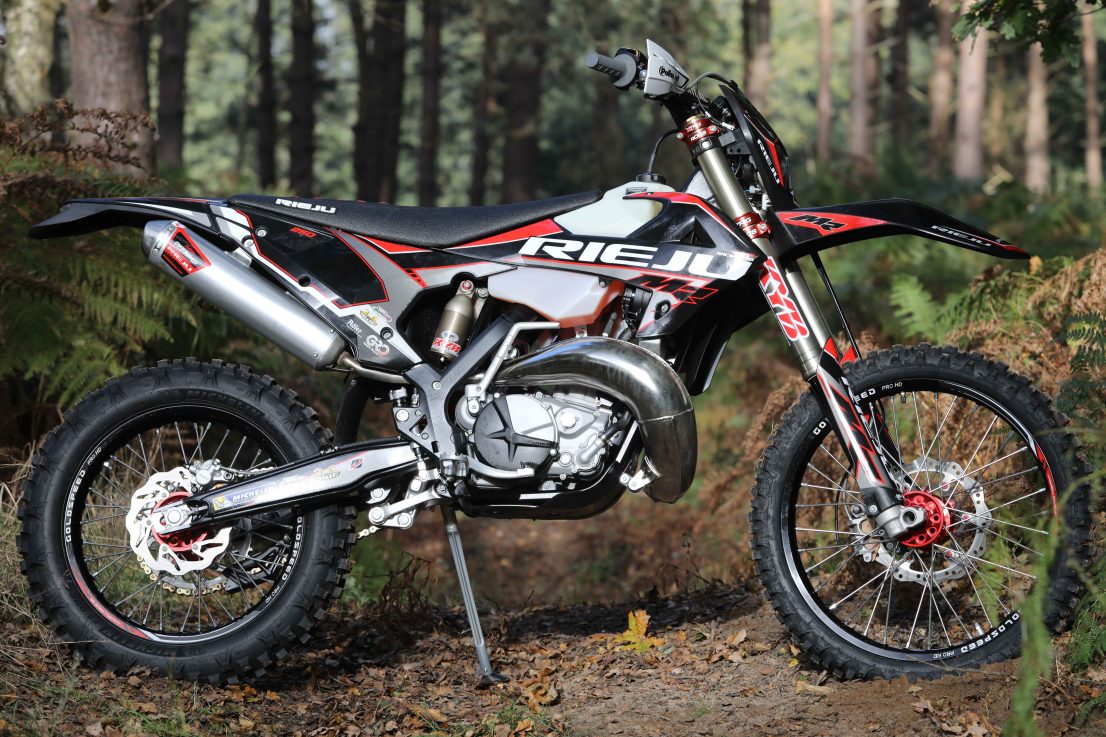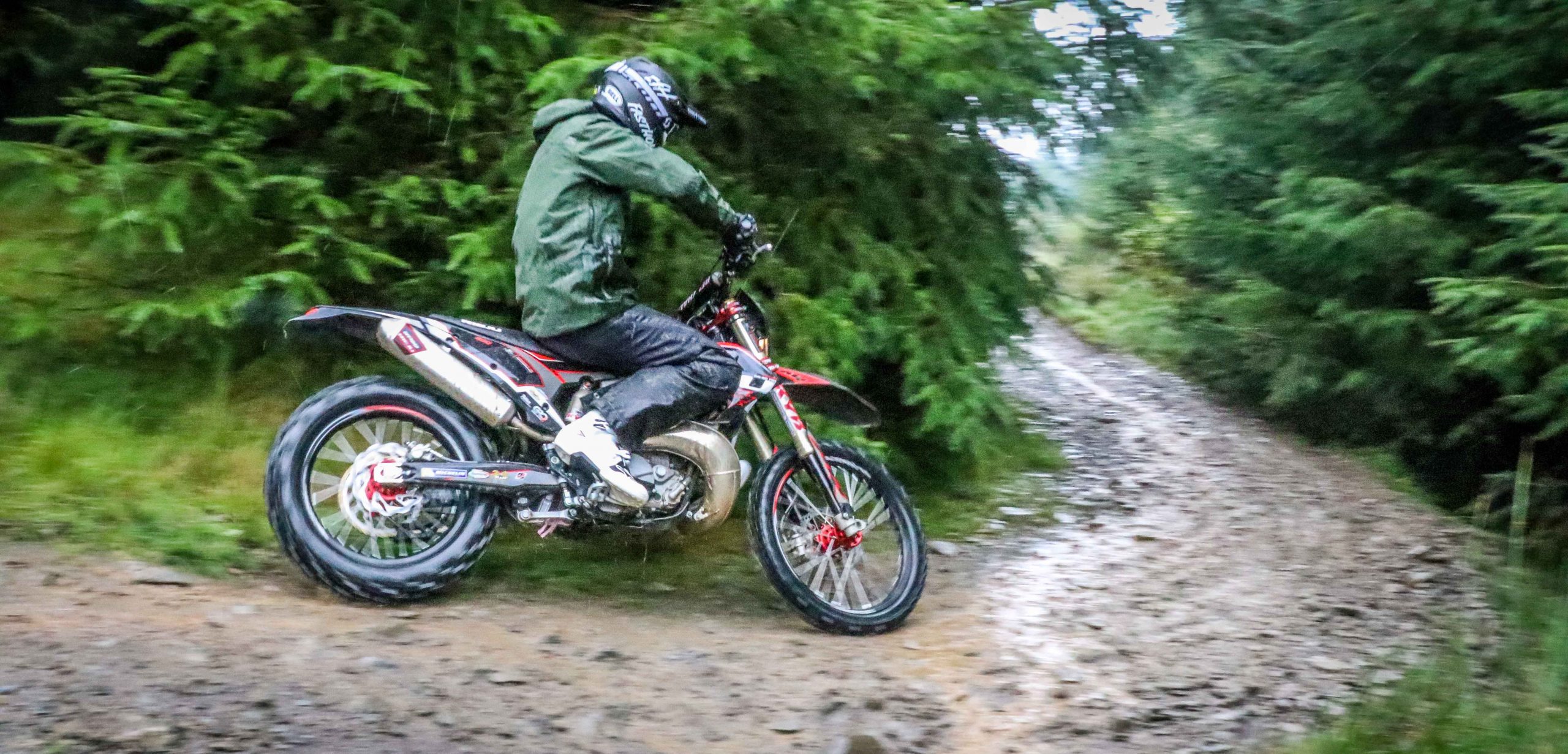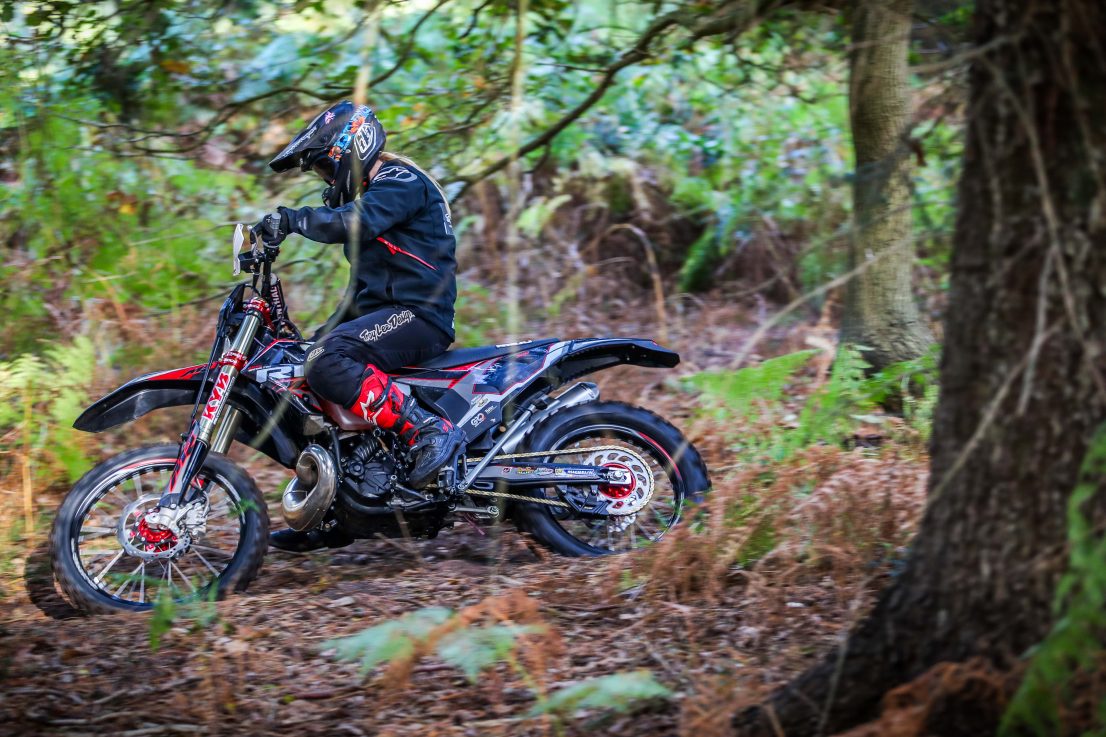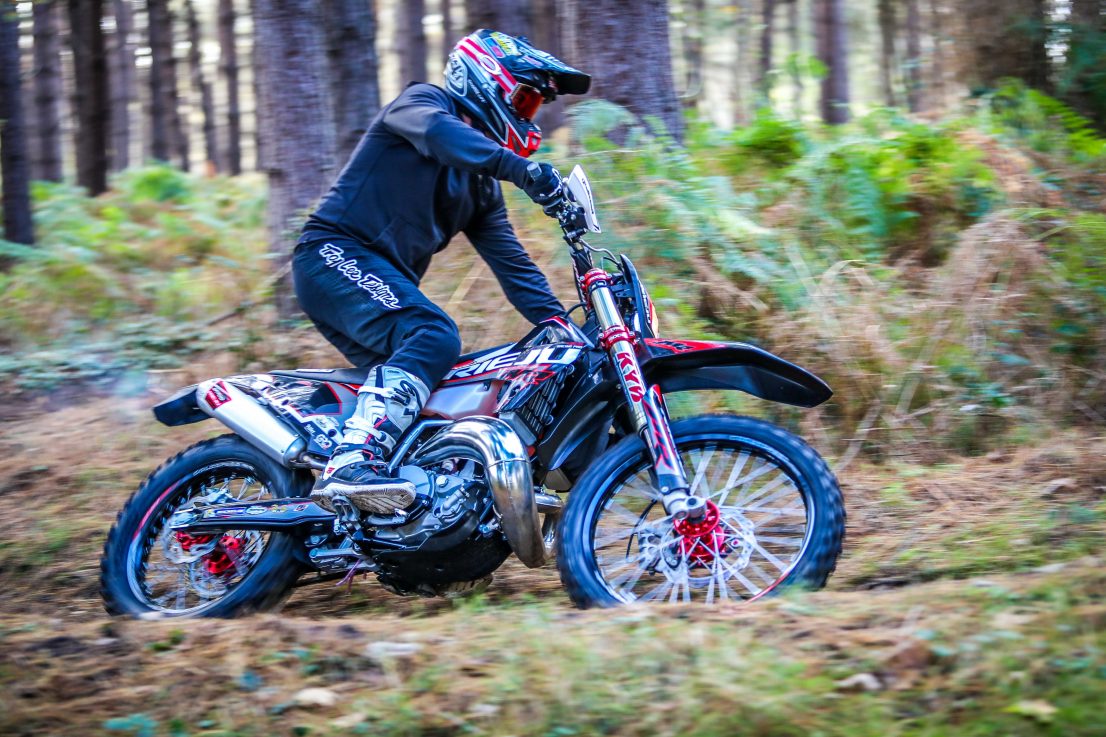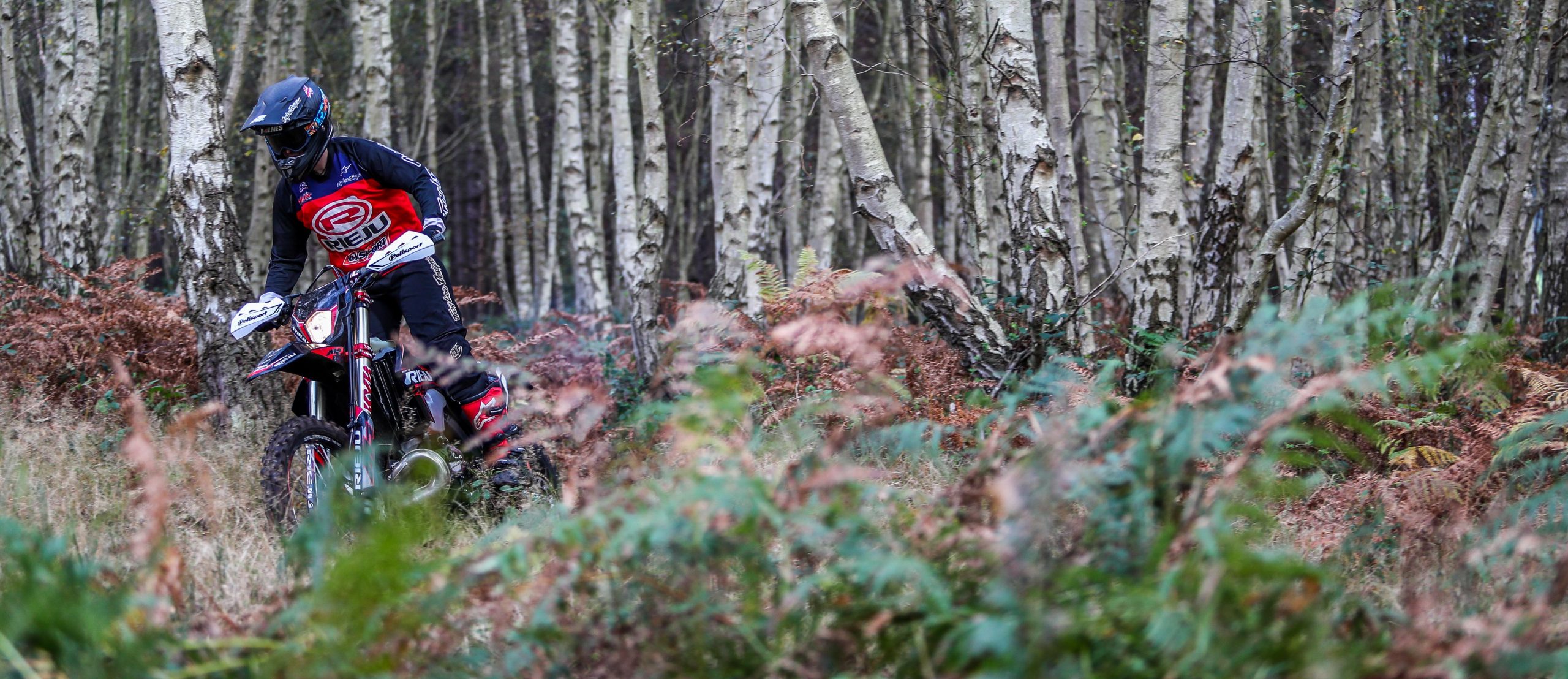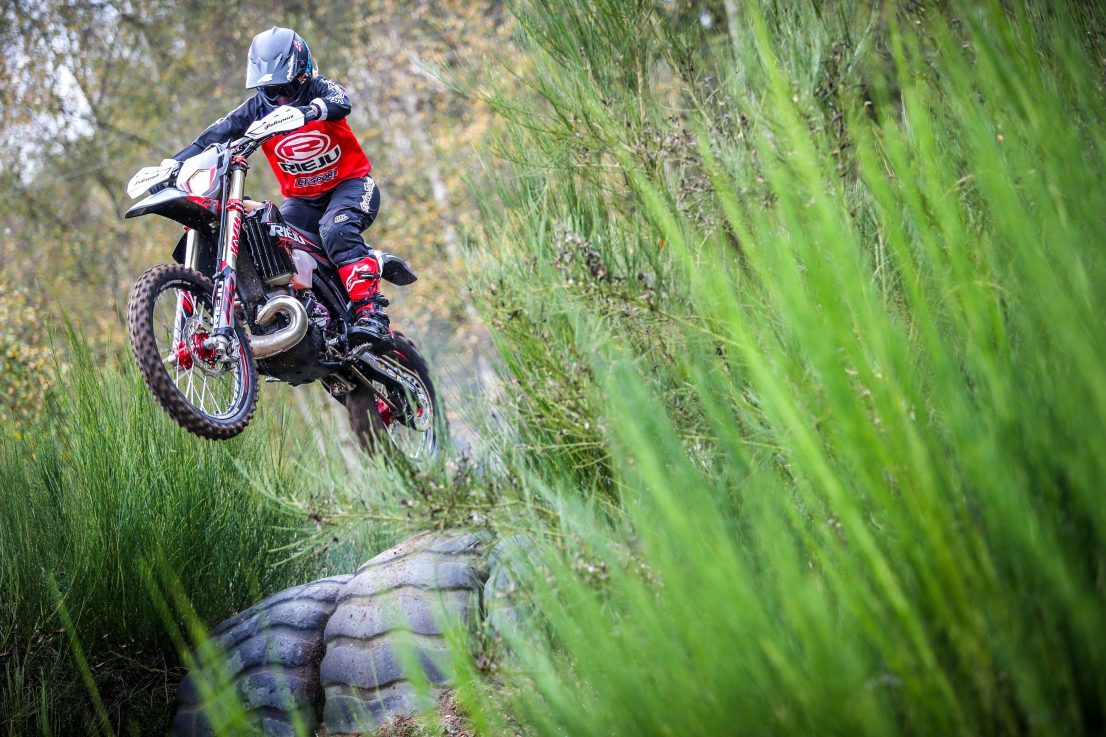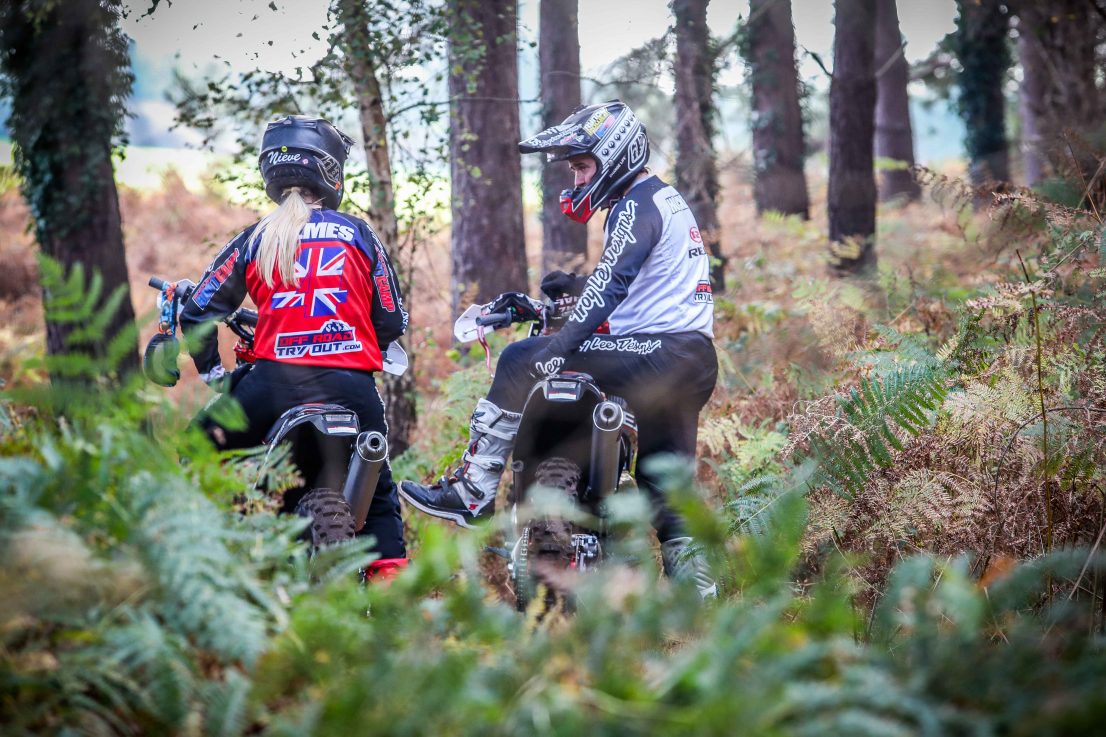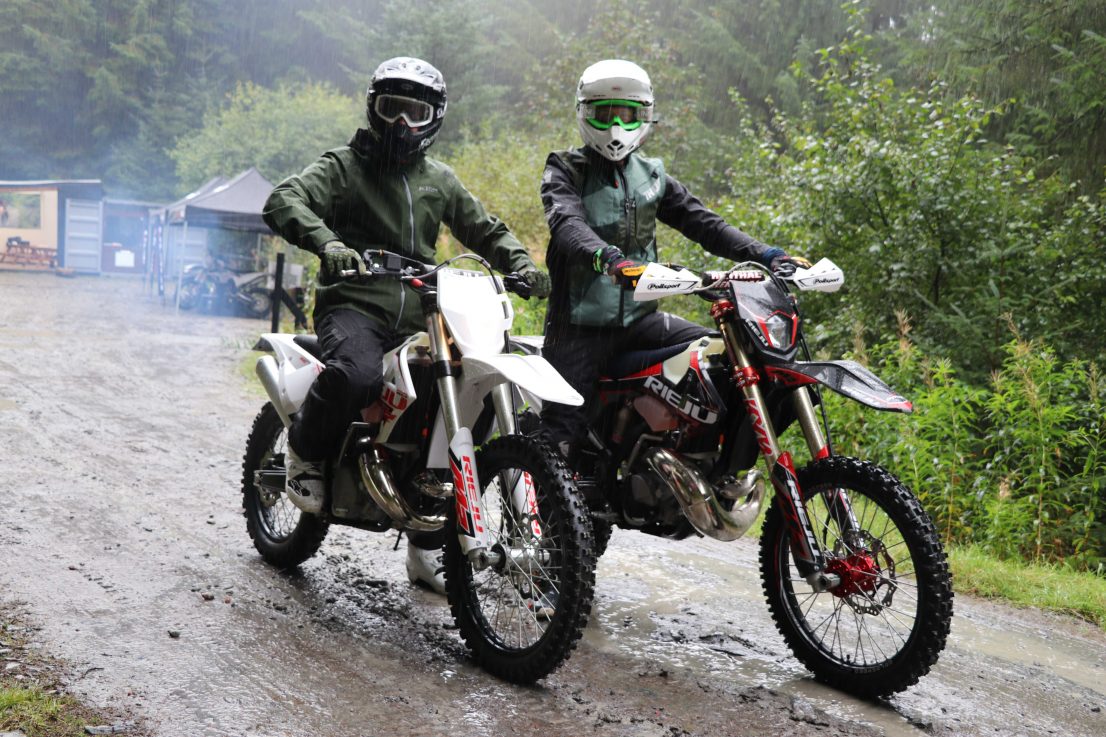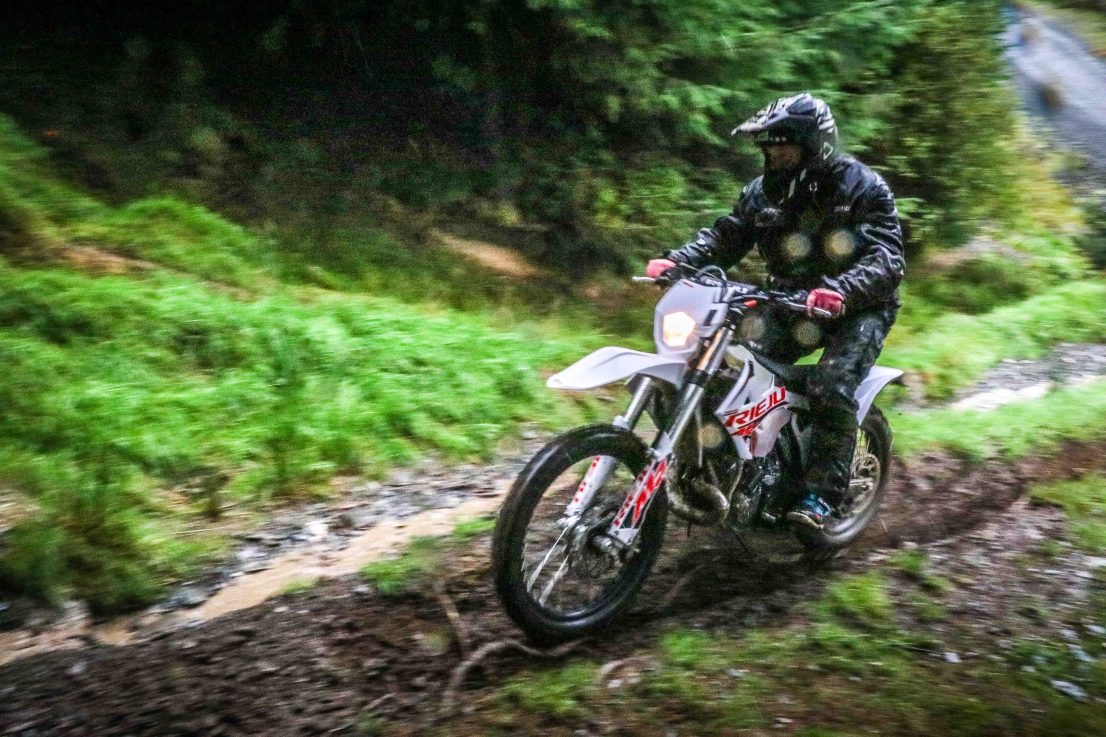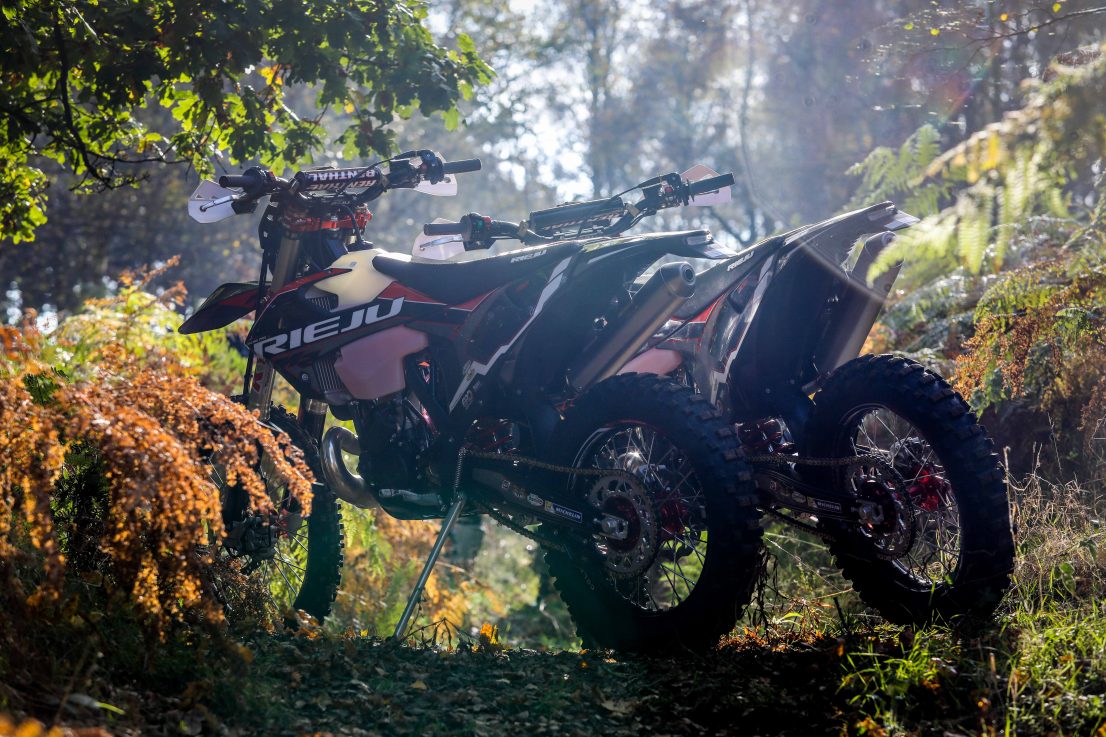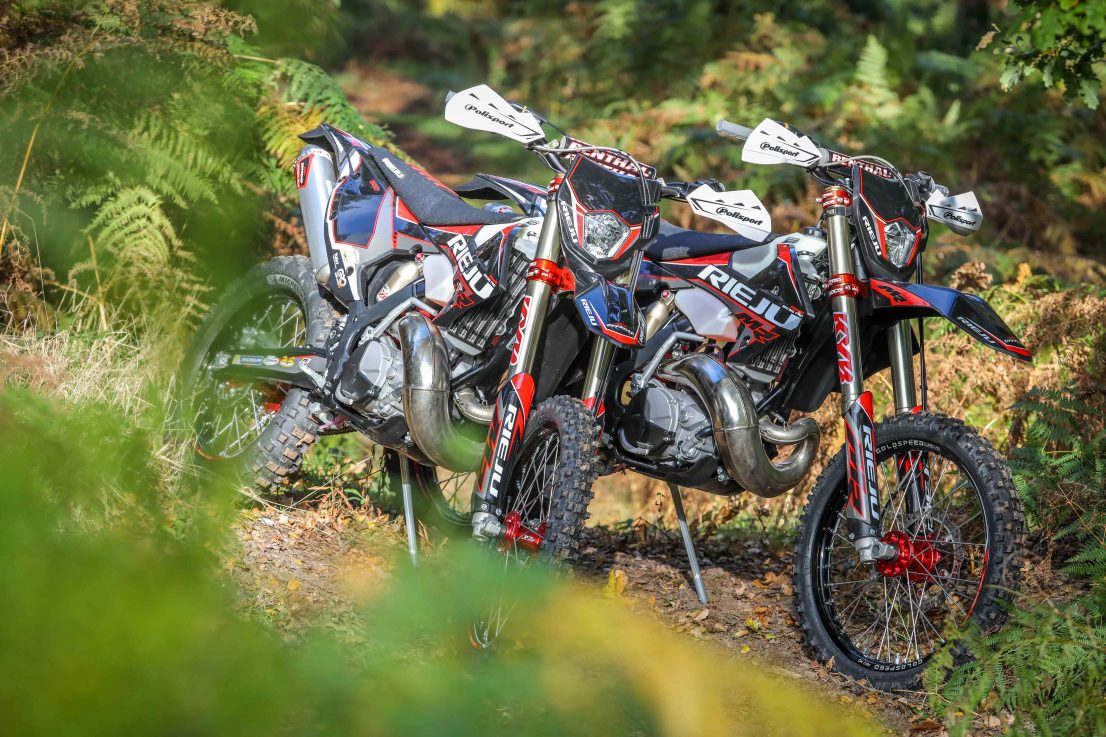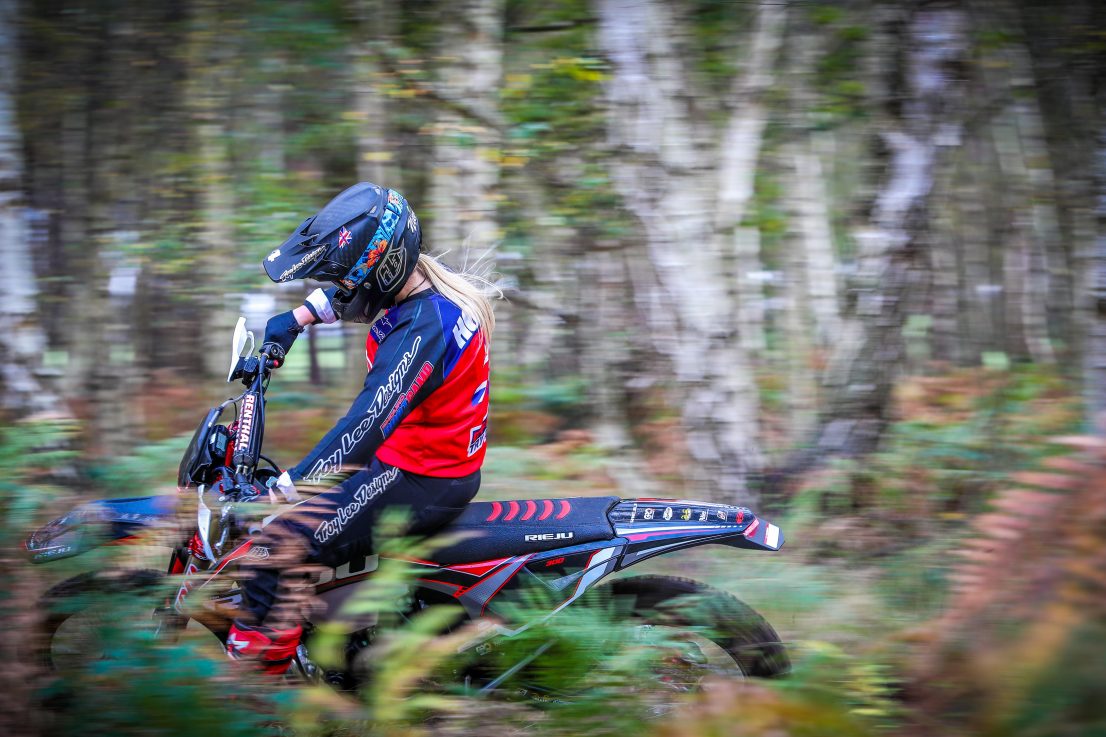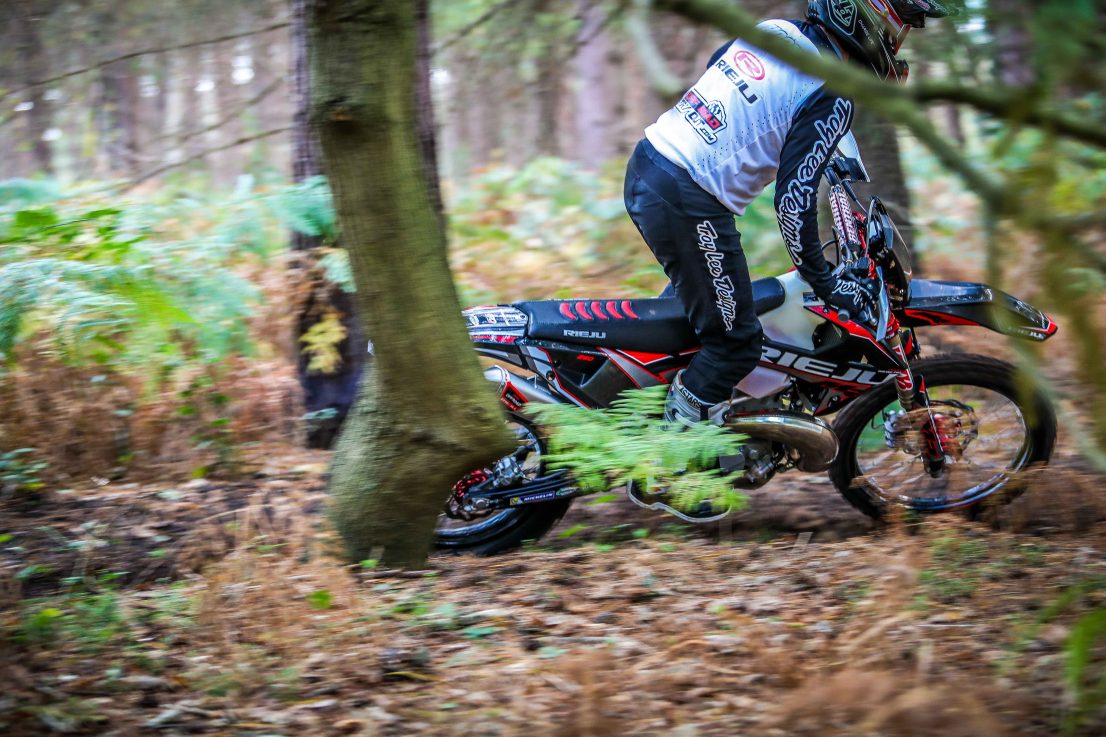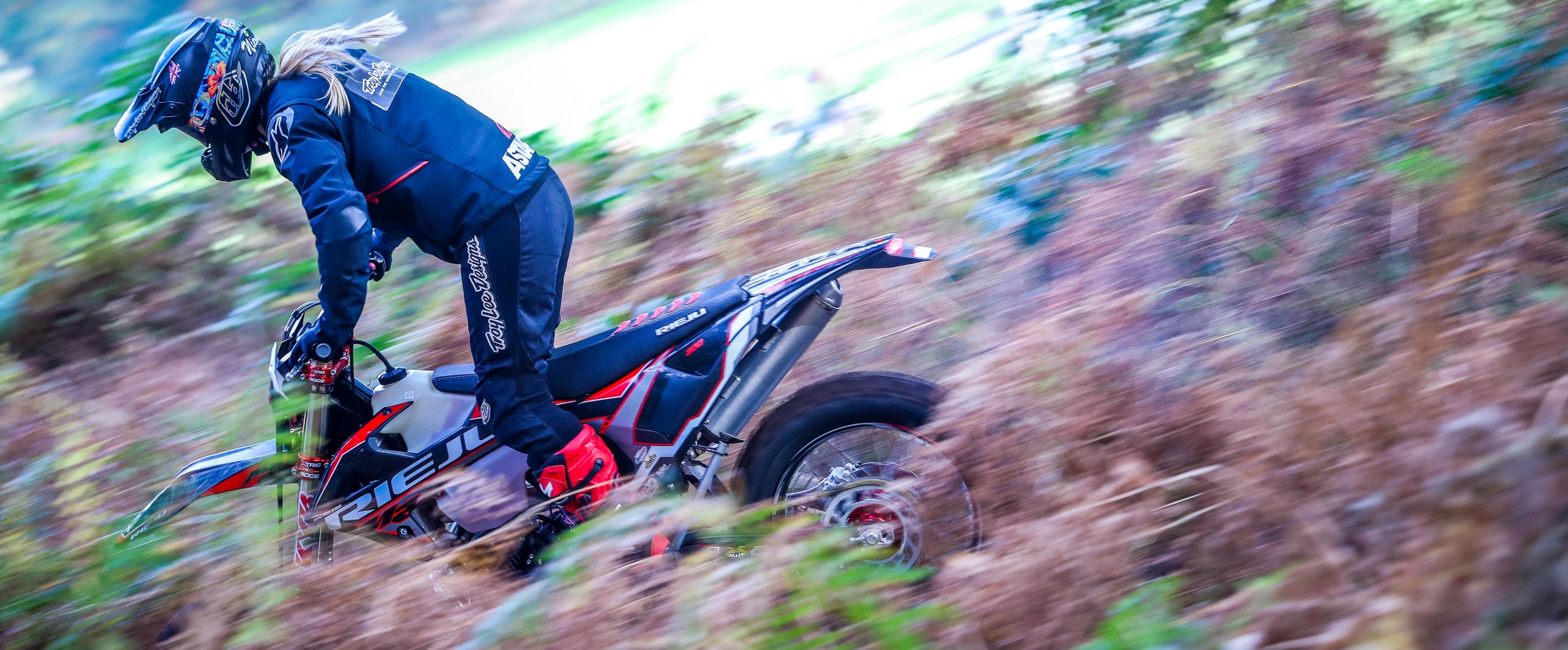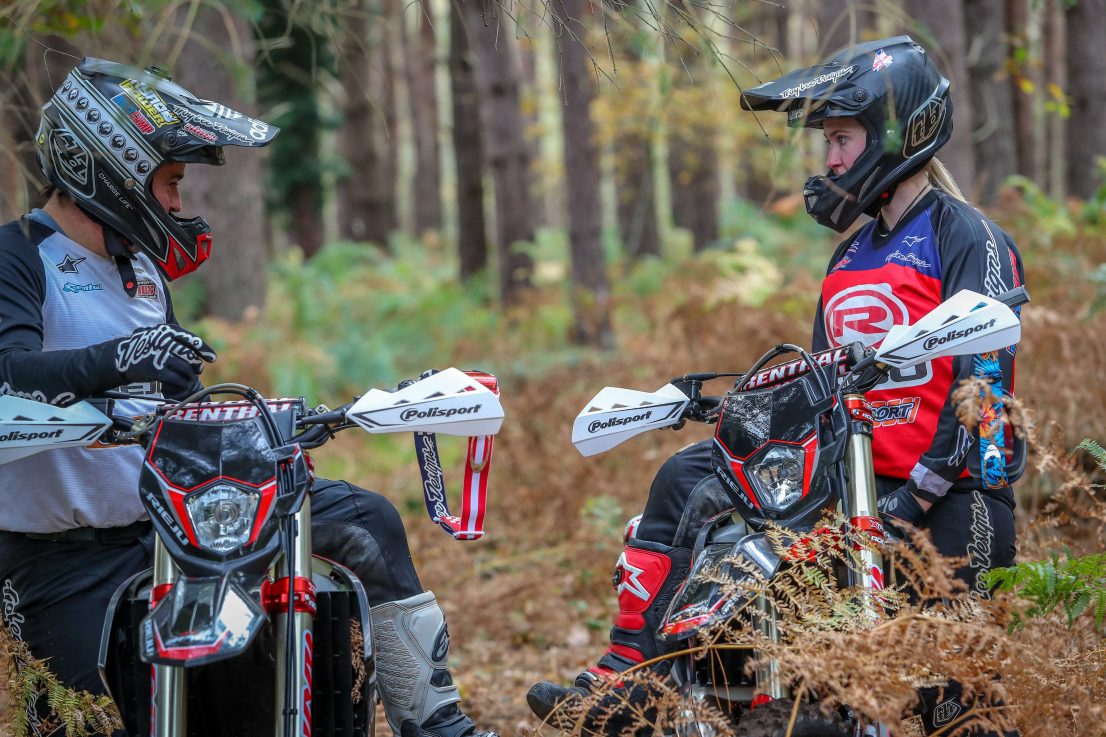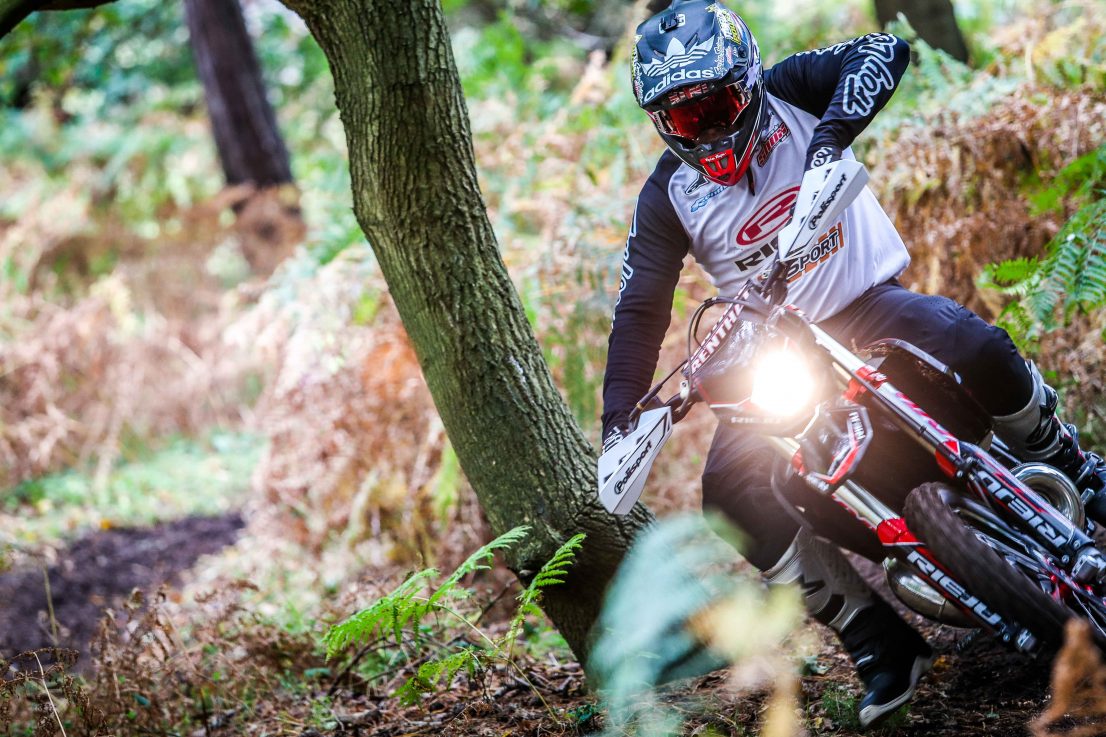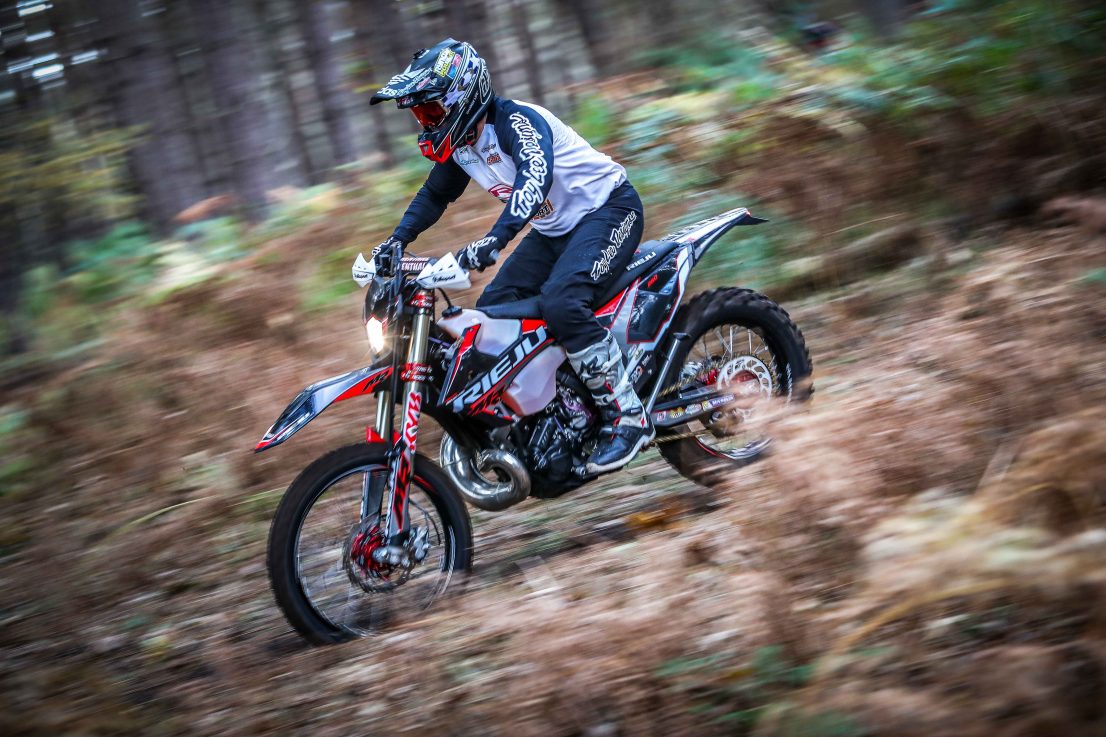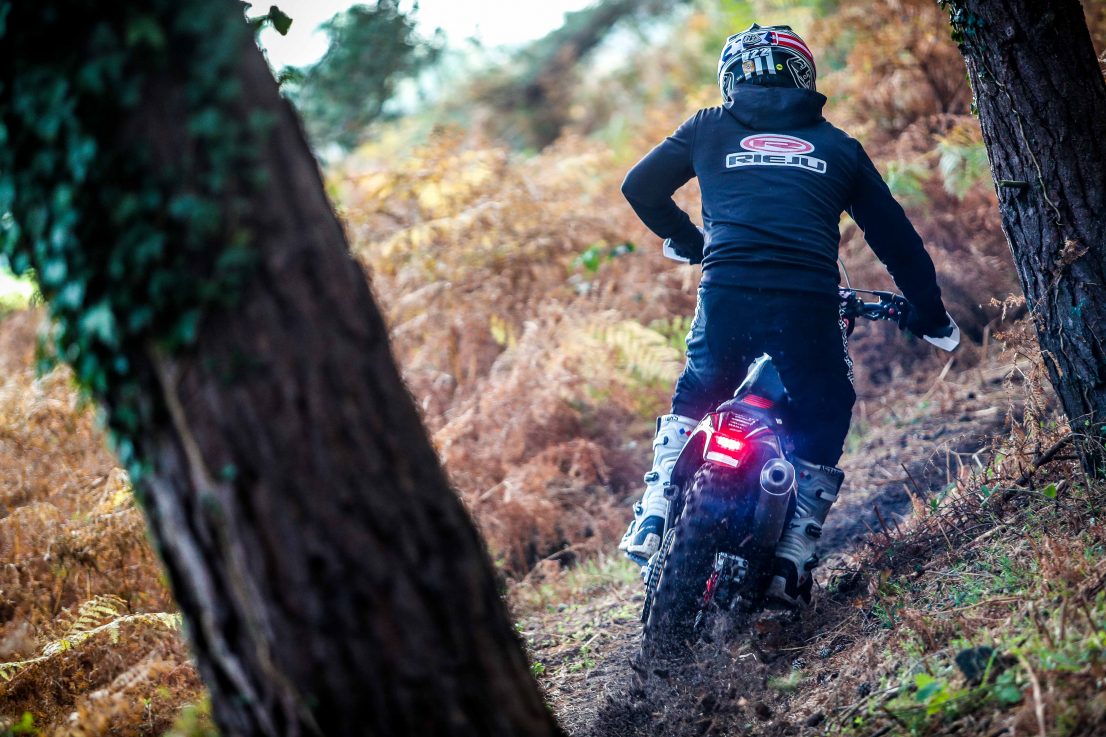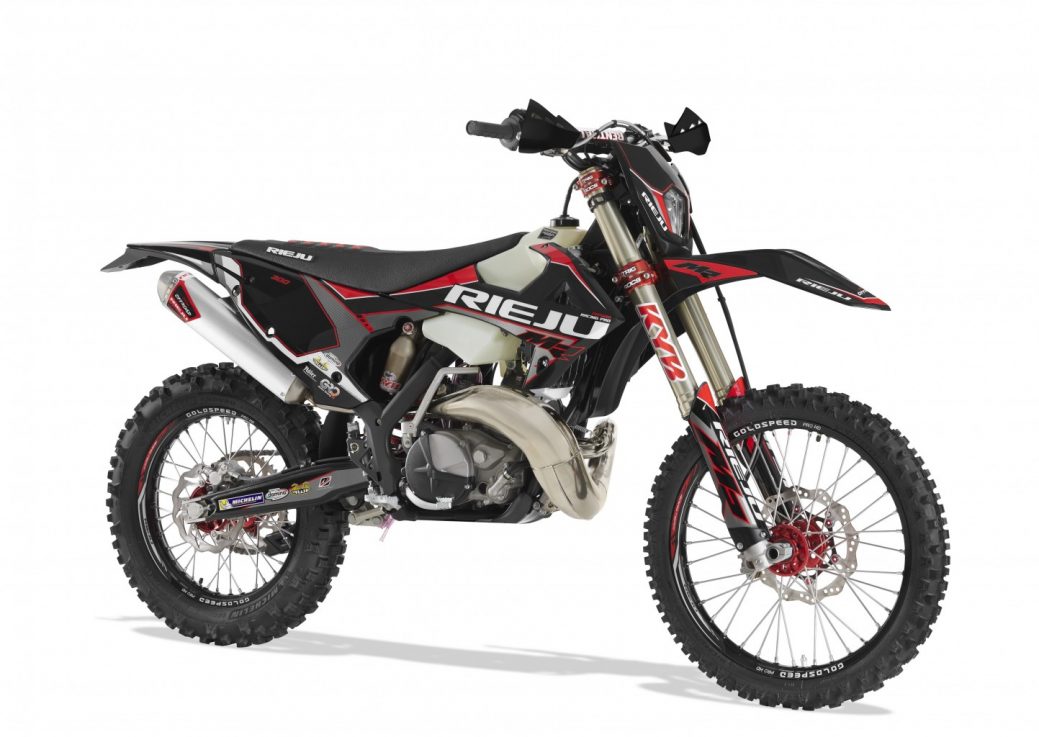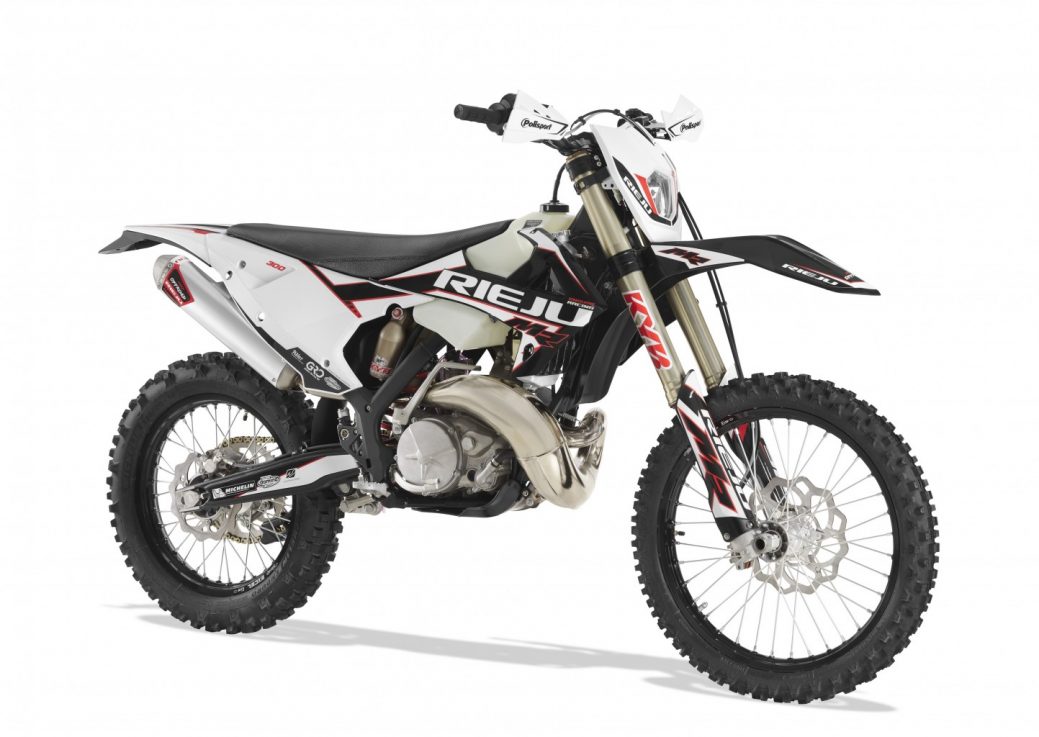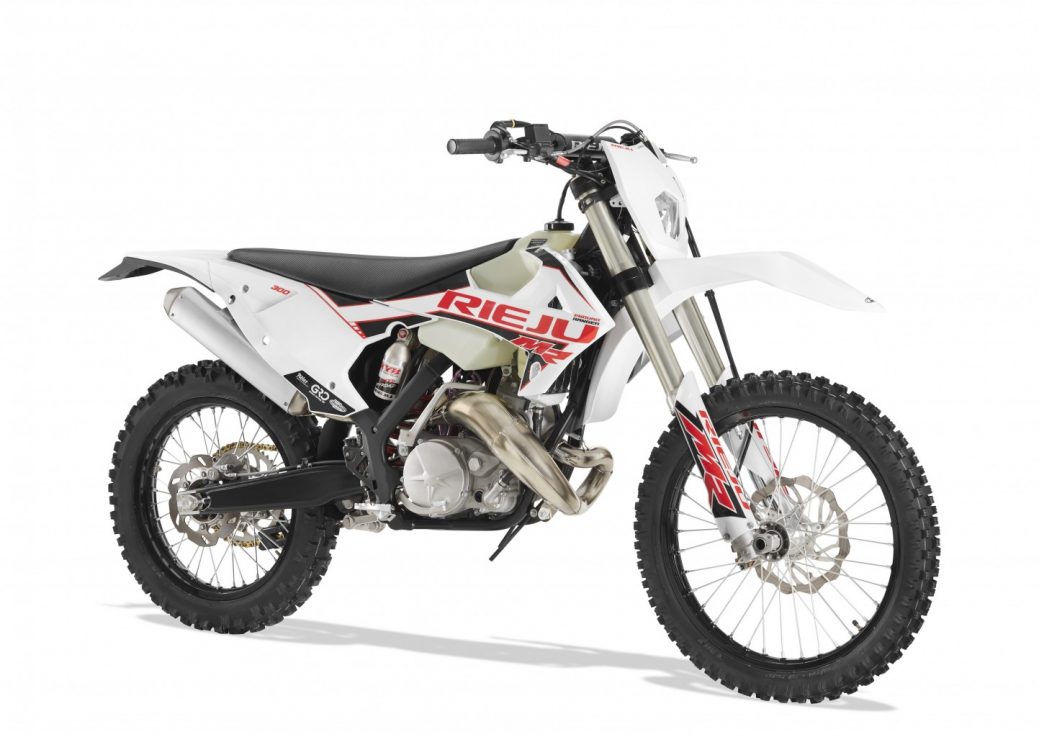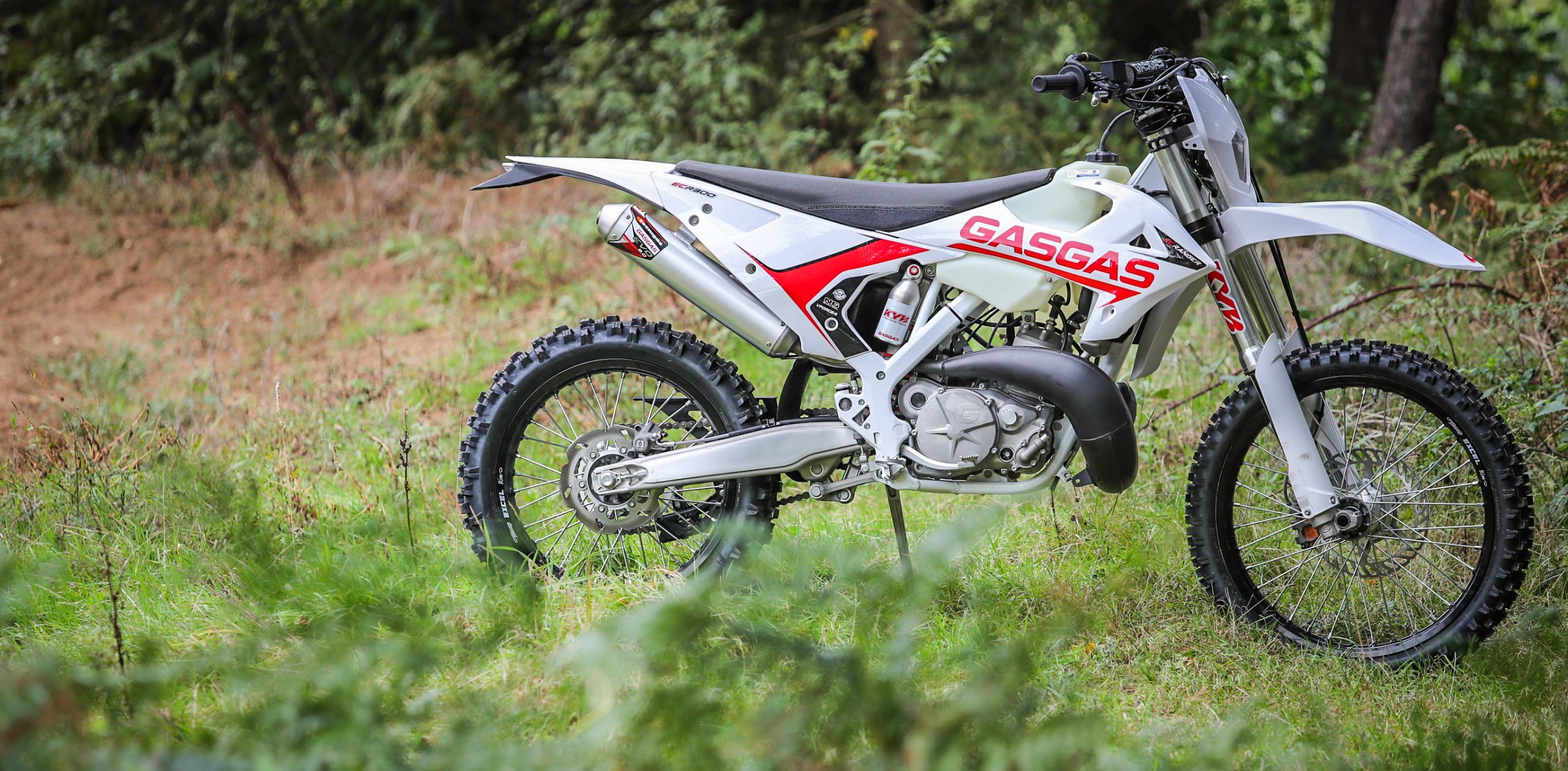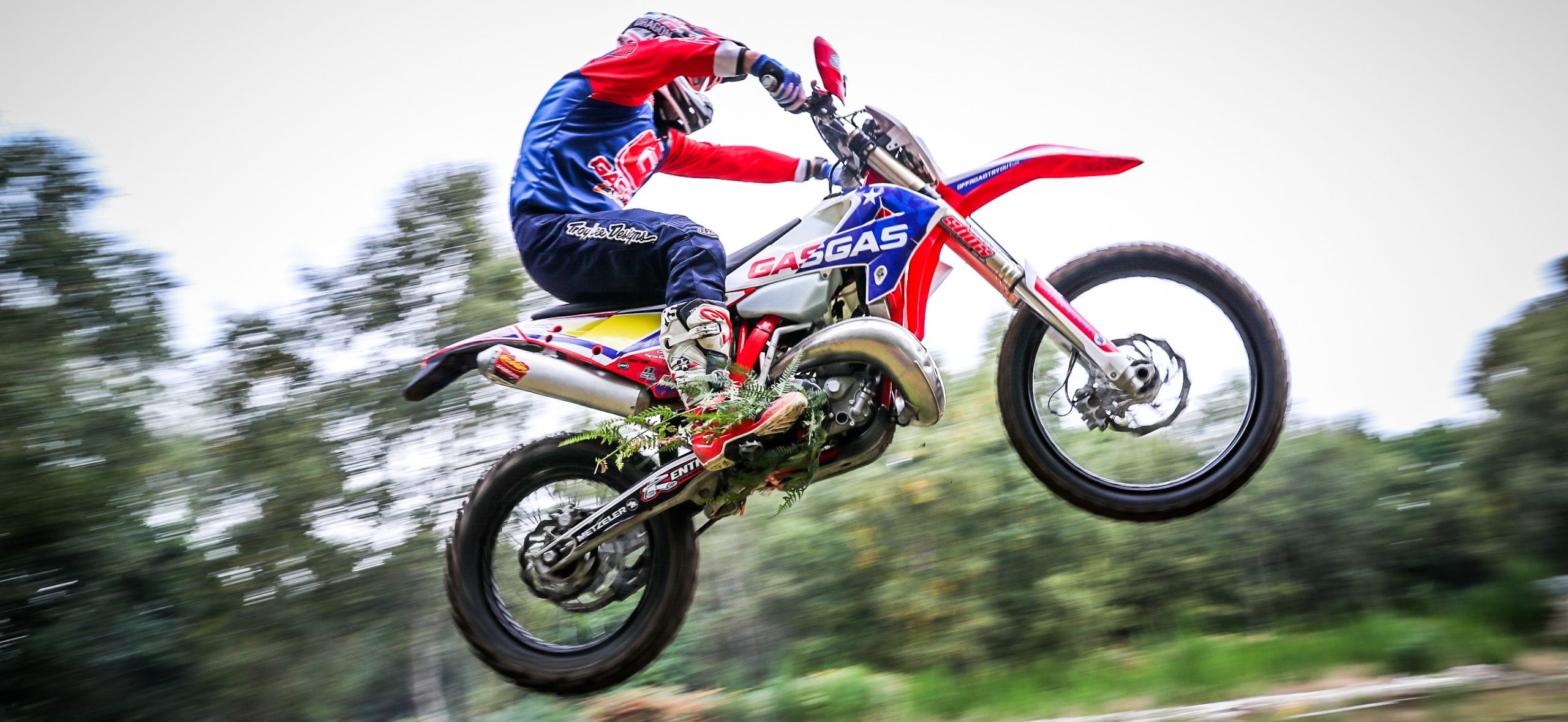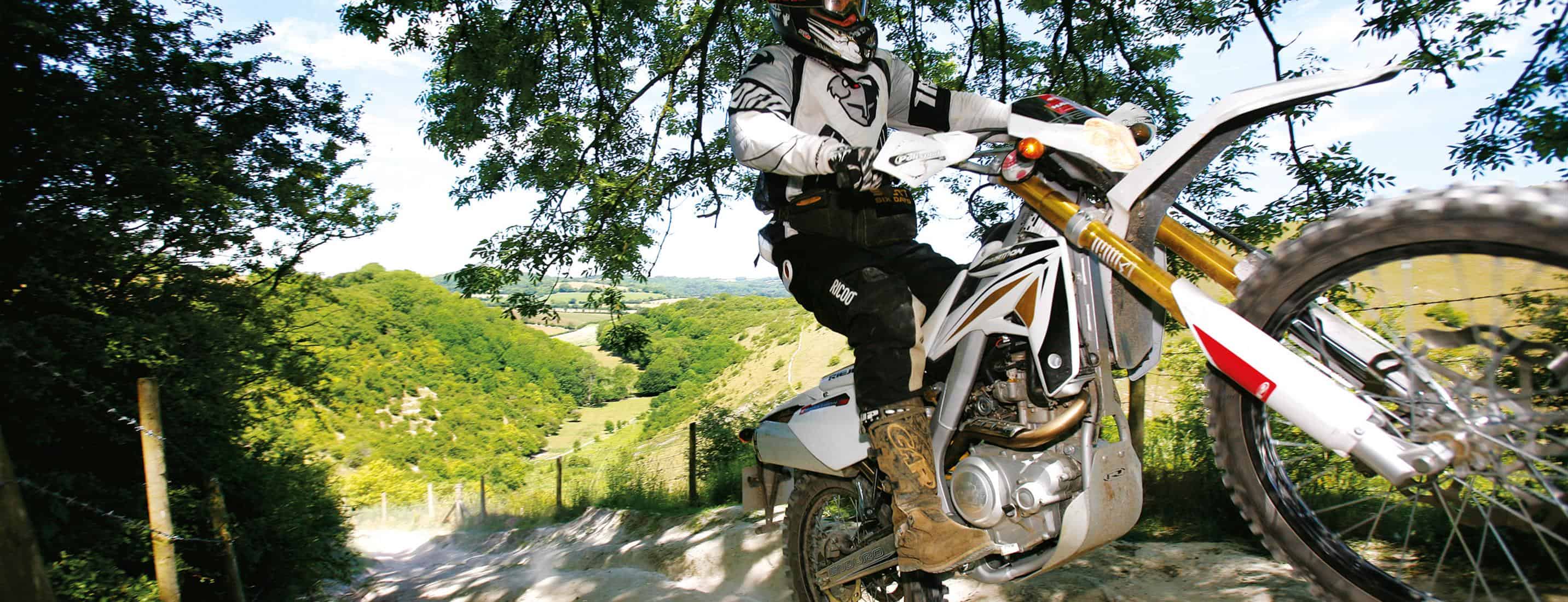words: Craig Keyworth & Jonathan Bentman images: JB (Suffolk) / Motomondo (Wales)
riders: CK & JB (Wales), Nieve Holmes & Chris Hockey (Dr Shox Boot Camp / Kiwi’s Bike Shop) (Suffolk)
So here we are. Sitting in a conference room in a hotel in Wales looking at some rather slick looking new enduro models. First things first, the name. I assumed initially that Reiju were Indian. My neighbour, your archetypal mechanic who rode bikes a few years ago, assumed it’s Chinese. Neither of us were correct, and in all honesty none of us know how to pronounce it, either. It’s Ray-Koo (or possibly even Ree-ay-hoo – with a rolled k-hoo in a Spanish style) back in Iberia, but in good old UK it’s accepted we’ll call it Ray-Joo. And, yes, it’s actually Spanish.
We had four models to investigate – all of them two-strokes. Two Ranger models (kind of enduro-lites, like Beta’s Xtrainer), in 200 and 300cc capacities, plus the MR 250 and 300s, in various trims (the standard Racing and the upgraded Pro). A top-of-the-tree Six Days model was there, too, looking splendid, although we didn’t get to ride it. Missing was the MR 200 as it’s yet to make its run down the assembly line back in Girona.
There was lots of talk of the other brands brought into the UK by Rieju’s importer (Motomondo), who were keen to impress us with their experience and standing in the market. End users don’t necessarily embark on research and/or generally enquire about importers, until they need back up, but here it would seem there is sufficient clout to supply big enough bike numbers, and get behind the spares and support, too. Great news.
A QUICK SPEC CHECK
So, in case you’re the one dirt bike rider who hadn’t read any news in the past three years – Rieju is the Spanish small motorcycle manufacturer who bought up the Gas Gas tech and tooling when KTM made off with Gas Gas branding (and trials bikes). In the final years up to the end for Gas Gas the firm had actually been quite busy with their R&D, so their final enduro models, including the EC 300 – now an MR 300 – were on top of their game. New frames had modernised the handling while the choice of Kayaba for forks and shock gave them topflight suspension. In fact, the whole package had found a new level of quality as we expressed in our last Gas Gas test in RUST #44 (December 2019).
Rieju haven’t just added new plastics and name to the old Gas Gas formula, though. R&D has continued so these new models now feature new cylinder head brackets, new starter motors, revised ignition mapping, new clutches and a new silencer as well as smaller changes like a new gear lever and kick start. Equally Rieju has reached again for the top shelf when it comes to spec’ing the models, so for instance the MR Racing models now get Excel rims, while the Pro model features anodised billet hubs and Goldspeed rims, X-Trig triple clamps, nitride coating on the fork legs and Renthal handlebars, the Six Days goes further with a New Cross skid plate and S3 footrests among many other upgrades. In short, they’re going for quality.
TO MICK’S…
The next day, at Mick Extance’s off road centre in Wales, I made a point of first jumping on the bike I’d probably have picked if I was spending my own money: the MR 300 Pro, mostly because it looks the best, but also is closest to how I’d run a two-stroke enduro. I ran a Husky TE300 for a year on my return to enduro, the first two-stroke I’d had since the old piles of crap I’d very briefly (and secretly) owned in my late teens. I both hated and loved that Husky. As I’ve said many times, I never cut my teeth on two-strokes, and I’m a bit rubbish on them, but I eventually got my head round my Husky enough to wobble around the Romaniacs week in 2019.
Jumping on the MR 300 and riding off behind Adam (Extance) into now familiar-ish territory, I was instantly back home, no two-stroke bog but it needing to be in the right gear, so we just got straight down to it. Fabulous. For my mind, probably the biggest issue across the range was found right at the outset. The starter button is on the left handlebar, and it’s weird. I’d change it straight away, as if you’ve stalled it, you really want to be able to pull the clutch in and press the button easily. A small thing, but it grated throughout the day.
As it happens nothing really jumped out about the MR 300 in the first 10 or so minutes. Whilst this doesn’t sound complimentary, it’s actually quite the contrary, I found I just got on it, and got on with it. Bear in mind the fiddling I’ve been doing with setting up my own bike, this is actually quite astounding. Out of the box, as ever, the KYB suspension was stiff, but was surprisingly quick to supple up, and there on was right on point. The MR 300 will lug like a decent four-stroke but give it the beans and there’s no mistaking what you’re on, it’s away. I liked it. A lot.
THE RANGERS
At the risk of falling into my usual test bike MO of hogging the one I liked, I selflessly forced myself onto the 200 Ranger next. It’s a curious thing the Ranger, it’s actually smaller in many directions than I’d assumed, it’s not simply a short-shocked MR but a genuinely shrunk bike, with the frame pulled in up, down and front to back. The motor is also tamed right down, and noticeably smoother and calmer right off the button (which remains on the wrong side). The 200 isn’t a quick bike, but if I’d taken a role at Mick’s school, and I had a road rider who wanted to venture off-road for the first time, or even a total novice, this would be their bike. This isn’t to say it’s not a capable bike, it is, it’s very much like the bastard offspring of an enduro racer and one of those Randonee high-seated trials bikes the Spaniards love for a day in the mountains. It’s is very softly sprung though; the Sachs set up is like an old school XR and I’ll be honest, it was way too soft for me. It was also not quick. You could make it sing nicely, and it smelled like we’d put a decent turn in, but truth be told it was a bit lacking in the pace department and I needed first gear for a couple of the trials type ascents. It did its job mind, and for a day out in the mountains or as a green laner, which is really its intended market, you’d be hard pushed to fault it.
The 300 Ranger is the same bike, but unsurprisingly with more get up and go. It was mostly falling between gears, though, suggesting it’s geared as per the 200. I think I’d drop a tooth or two at the rear, as I think it’d greatly improve it. Again, it sounds like I’m down on the Ranger, but I’m not, it’s a great bike and I think it’s probably out on its own as an almost raceable trail bike. I know of one that been prepped right up for a short rider and it’s basically a mini-MR, so the beast is within, but that’s not really its thing.
THE NEW STARTER…
Now the bikes we tested were called 2021-and-a-halfs. The spec pretty much as the 2022s will arrive, save for the starter motors. The starter motors have been a reasonably well-known problem with the old Gassers, the problem being associated with a starter mounted perpendicular to the cranking direction, with the requisite Bendix drive. The Bendix is essentially a pinion gear on a spring – it’s thrown forward to engage the ring gear, usually on the crank or flywheel as the starter motor spins, and vice versa – it cannot stay engaged once the bike fires as the engine would drive against it. Now it causes a few headaches with longevity, naturally it’s more complex than if it had less moving parts – the same problem as it happens that KTM had when they did the same thing with their own two-strokes previously, circa 2013 ish. KTM threw money at it and completely redesigned their casings and frame to accommodate a neat tucked in starter positioned in line with the crank. The plan with these Riejus is the new starters will be oil cooled. We can confirm that this is its own oil, rather than in the engine oil circuit, and it’s a small amount with a hose used as a reservoir – a workaround/mod used to good effect on those previous KTMs. It’s not quite as robust as relocating and rotating the whole starter motor, but it’ll solve the problem for almost all users, with the possible exception of schools and prolific stallers/folk with zero mechanical sympathy.
The other issue I see is the range. Personally, I think there are too many models. It’s a bit like pushbike line ups. There’s a base model, a few in the middle and then the top of the line – but does there need to be? Time will tell for Reiju’s UK importer.
Back to the riding, the MR 250 versus MR 300 thing is entirely down to preference. For me the MR 300 can be ridden more smoothly, and there’s serious low-down torque. I found the revvier MR 250 broke traction a little quicker, but a (another) day on the bike and it’d be mastered, or at least managed in my usual style. Both pulled incredibly well, and coupled with the tight, precise handling, especially in the steep, off-throttle descents, they were a joy to ride.
We actually went off for a bit more riding when everyone else was either too wet or tired and embarrassed ourselves trying to get up and down Wales’ answer to Romaniacs-level tree-lined cliff sides. Much fun was had, but it was the kind where you clip finger ends and shoulders off things that don’t want to move. Trees and the ground for the most part.
HAPPY DAYS?
So, in summary what did I think? I was impressed, certainly. The spec and capability of these bikes is impressive. They perform with the best. Being premix and carb’d you could call them either traditional or old school – and yes, you need to understand two-stroke jetting to have them ready to race. That’s really not that difficult to understand – quite basic in fact – but this is a generation behind the current crop of fuel-injected machines with automatic adjustment for atmospheric conditions. So, you’ll get your hands dirty while your mate is at most stabbing at a few numerals on his smart phone to optimise his ride. But fast has always been fast. Good handling has always been good handling. And the Rieju MRs are certainly this, no question.
To sign off, our test handily occurred only a few days prior to the opening of the 2022 Romaniacs registration, that I promptly sat down at the laptop and got my entry in again, should tell you all you need to know. Time for another two-stroke.
SECOND OPINION
JB
I’ll make no pretence – I like this bike, a lot. I’m talking mostly about the MR 300 Pro here, but all these Riejus are very good, it’s just the MR 300 Pro model really shines out.
This MR 300 Pro is an unapologetic competition machine. But more than that, it’s one with soul. It’s as if it carries within it all the experience, the wisdom, the knowledge of all the engineers who have over the years (decades) refined it into this super-focused enduro machine. The chassis fits my size so well, I’m not cooped-up, it feels custom made, and I appreciate the low handlebars are giving me the best connection to what the front end is doing. The KYB suspension works without fuss, I need to carry a lot more speed and hit much bigger obstacles to get anywhere near to unsettling it. Meanwhile the 300 motor is just so right for enduro – when correctly jetted, mind, you do have to get it right – and the sweet-shifting six speed gearbox mean it has velocity to spare. The Nissin brakes match the expert setup – they’ve got bite! And while this 300cc two-stroke should really be too much for me – as an out of practice, out of fitness vet clubman – it wasn’t, I could use its torque and creamy low rev to make everything right. That could be skating across the muddy, slippery rocks in Wales or over the roots and through the whoops in the sand of our second ride in Suffolk. This beast, typically pulling third gear so imperiously everywhere, is simply a go-anywhere machine. Race or extreme, it’s doing it.
And the whole ride experience speaks of heritage and of lessons well learned (and applied) – it’s not trying to be flash, nor cutting edge, it’s just getting on with the job. For an expert this thing is a real weapon. For a clubman it’s an incredible learning experience, where you start at your now speed and over time it teaches you, it carries you forward to being ever quicker, ever more proficient.
You could call it old school. After all, it’s a two-stroke, carburetted, running on premix, there’s even a kickstart. But when old school scores straight ‘A’s, then that’s no criticism. Cracking tool, no question.
The MR 250 was called out as the better racer by our second test riders (Chris ‘Kiwi’ Hockey and Nieve Holmes). The 250 motor likes a little more revving, so you can’t be lazy, but equally – as Kiwi explained – it’s less likely to bite you when things get a bit wild. Younger people generally gravitate toward the 250s, us old bluffers, we go 300.
The 300 Ranger I totally got. It’s smaller and more docile than the MR and as a green lane machine it would score very highly. It’s super light, nice and quiet, and mega capable – and comes with a very manageable seat height. The 200 Ranger felt underpowered in the Welsh hills, it struggled, but as a first off-road bike, for teaching beginners, it has to be an ace card. Easy, simple, unintimidating.
Rieju have a mountain or two to climb. Their name being almost unknown in the UK is one. Perception that these are old tech (old Gassers) is the second. Hopefully customer experience will overcome this. One test ride on that MR 300 Pro would be enough to get a lot of riders thinking…
RIEJU MR 300 SPECIFICATION
Engine single-cylinder, liquid cooled two-stroke
Displacement 299,3 cc
Bore x stroke 72 x 72 mm
Starter Kickstarter (new lever) and electric oil bathed
Cooling Radiator + Electrical Fan
Ignition Digital CDI – Euro5
Double map Dry / rain
Carburettor Kehin PWK 38
Intake system Direct reed valve VForce 4
Transmission Six speed, multidisc wet clutc with Magura hydraulic operation
Exhaust muffler Tecnigas – RIEJU Powered
Chassis Central spine in Chromium Molybdenum Steel
Subframe Aluminum
Swingarm Aluminium and Linkage system
Front fork KYB 48 mm, AOS System, Closed Cartridge Anti-Friction Treatment DLC
Shock Absorber Shock absorber with gas tank KYB
Front wheel/tyre 1.6 x21 – 90/90 – 21 M/C 54R Michelin Enduro Medium F TT
Rear wheel/tyre 2.15 x 18 – 140/80 – 18 70R Michelin Enduro Medium R TT
Front brake 260mm floating disc Nissin caliper
Rear brake 220mm disc, Nissin caliper
Dimensions Length x width x height : 2145 x 810 x 1235 mm
Wheelbase 1480 mm
Seat height 950 mm
Fuel capcity 9,8 L
Dry weight 105 kg
RIEJU 2022
UK PRICES
MR 200/300 RANGER: £7299
MR 200/25/300 RACING: £7599
MR 200/250/300 PRO: £8599
MR 300 SIX DAYS: £8999
